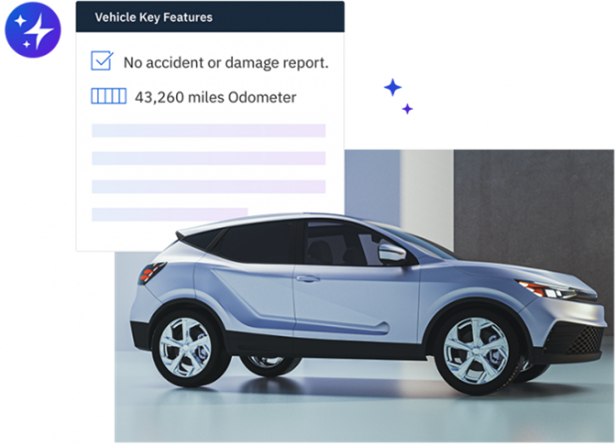The Art of Making Fast, Accurate, and Profitable Inventory Decisions

Article Highlights:
- Making accurate appraisal and pricing decisions is difficult to do quickly.
- Learn how improving your used vehicle data can help.
In the used vehicle world, speed and accuracy are the name of the game.
Whether you’re bidding on cars at auction or working a trade, you need to make appraisal and offer decisions quickly. And as profit margins narrow, valuing inventory correctly has become more crucial.
But, making accurate appraisal and pricing decisions is challenging to do on a time crunch – especially when the market can shift dramatically from week to week. It feels like you can only be fast or accurate, but not both.
What if you didn’t have to choose? Let’s take a closer look at how you can achieve speed and accuracy in your used vehicle department.
Seamless Connection
The best way to speed up the used vehicle process is by using a connected system to search for vehicles, make appraisals, manage your inventory, and track reconditioning.
Connection matters because you can eliminate the tedious tasks that slow you down – rekeying details between technologies and manually relaying vehicle status updates to different team members. You’ll also have instant access to data so you can make informed decisions faster, from acquisition to merchandising.
Let’s take a deep dive into a few key areas to see how this works:
Acquisition and Appraisals
When looking for inventory with a connected system, you can search for cars from one central location and easily view appraisal information while doing it. You’re able to search a wide variety of sources – online auctions, marketplace websites, and even listings from private sellers – so you don’t have to spend time bouncing between different websites for inventory.
Additionally, you can instantly see vehicle history, book values, and pricing recommendations alongside every car you consider. Not only does this make for more accurate appraisals, it also eliminates back and forth between inventory sources and your appraisal tool, empowering you to review more vehicles each day.
Reconditioning
Unexpected reconditioning costs are one of the biggest challenges you face as a used vehicle manager. But when your reconditioning tool works with your appraisal technology, you can get a better understanding of how much repairs will cost up front. When inspecting a vehicle, you can note needed maintenance, see precisely how much it will cost, factor this into your offer, and ultimately protect your profits.
Once you accept a vehicle into your inventory, with a connected system, you can get a jump on the reconditioning process. Instead of tracking down your service manager to give him a run down on the vehicle, he will be able to see inspection notes directly in your reconditioning tool, making it easier to fill out a work order. Additionally, your used car manager will have visibility into the original appraisal information with the recon quote, allowing them to make fast and informed decisions about what work orders to approve.
Data-Driven Decisions
Saving time with accessible information throughout the used vehicle process is one piece of the puzzle. But the other piece is ensuring your data is as accurate as possible. You need information that is true to your market, dealership, and each vehicle in order to make the right decisions.
This starts with real-time data. In today’s volatile market, using last week’s book values to price vehicles doesn’t cut it. Neither does using comp sets that include cars that have already been sold. Comps that are refreshed daily are a must.
In addition to this, you need comps that match precisely with the vehicle you’re appraising or pricing. Details down to the trim level and exterior color can significantly impact how much customers are willing to pay for a vehicle. Your pricing tool should automatically take these factors into consideration when making recommendations.
Finally, the information you use to make decisions should be easy to adjust so it reflects your unique used vehicle strategy. For example, you may want to filter your comp sets to exclude independent dealers so you’re only using other certified pre-owned vehicles to price your inventory. Or maybe you only want to see comps from dealerships that sell the same brand as you because off-make vehicles are often valued differently. Whatever the case may be, data that is flexible can help you meet your specific needs and be more profitable in the long run.
Not an Either/Or Decision
You don’t have to choose between speed and accuracy in your used vehicle department. It all comes down to the information you use to make decisions each day. For fast, accurate decisions, you need data that is up-to-date, precise, flexible, and readily accessible throughout your entire used vehicle process. Ultimately, this will help you turn inventory faster and maximize your profit on each vehicle.
Related Articles:

How to Leverage Predictive Analytics to Boost Sales Opportunities
14 years. That’s how long the average consumer is holding onto their vehicle, and this trend isn’t shifting anytime soon. When consumers hold onto their…

The Future of Variable Ops with Experts at NADA 2025
Explore how AI is transforming variable operations in automotive retailing with insights from NADA 2025. Learn about efficiency, profitability, and fraud prevention from industry leaders.

Decision made regarding the Vehicle Shopping Rule – now what?
Check out five key takeaways from the Vehicle Shopping Rule to keep your dealership safe from FTC enforcement actions.

3 Ways AI Can Elevate Your Dealership’s Online Inventory
On average, Americans are exposed to between 4,000 and 10,000 advertisements every day. From commercials on TV to billboards on your way to work, all…















